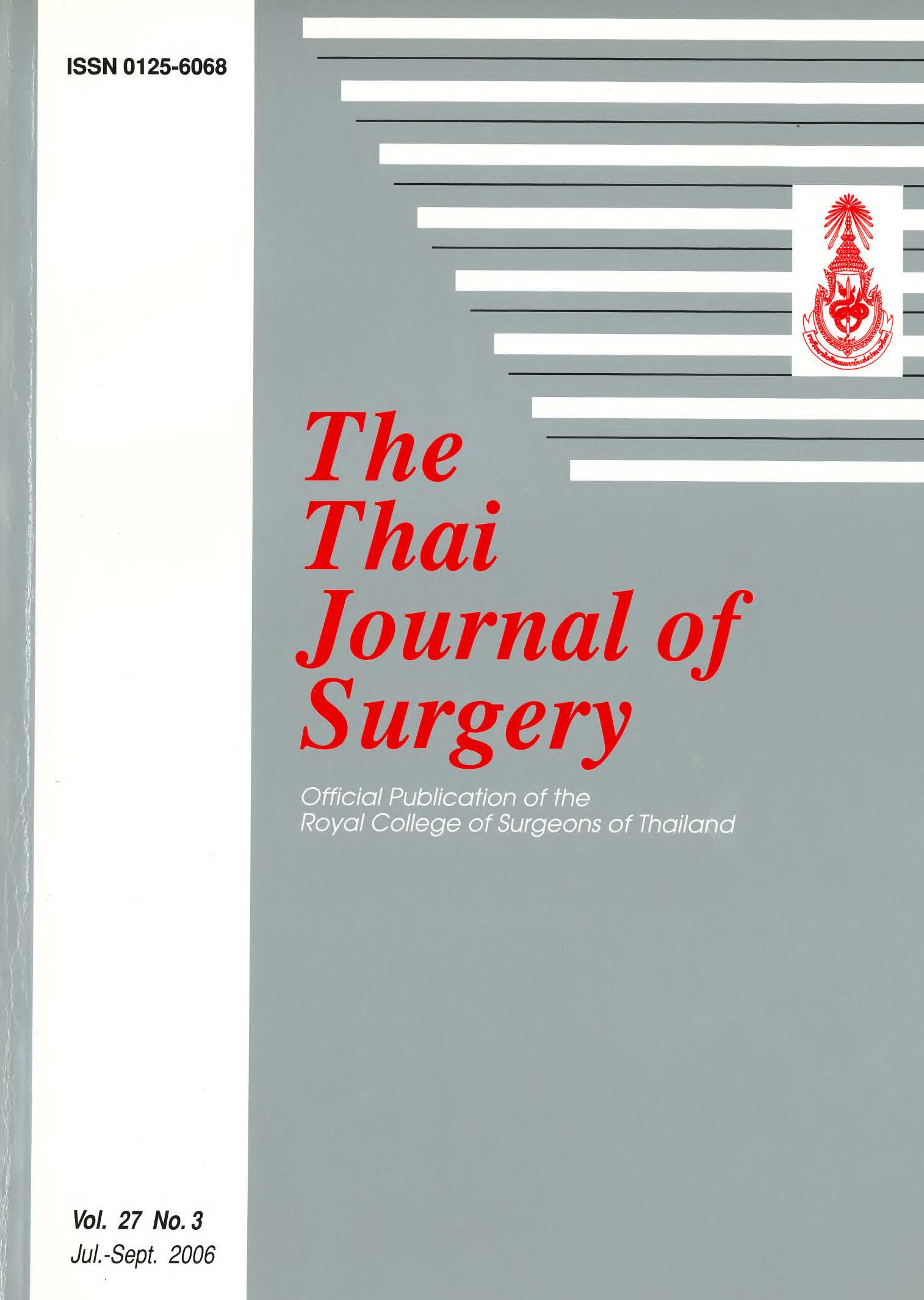Strongyloidiasis in HIV Infected Patient with Small Bowel Perforation: A Case Report
Abstract
Background: Parasitic diseases which are not common in normal host can become a serious infection in HIV infected patients.
Case Report: A 39-year-old Thai male presented with low-grade fever, abdominal pain and loose stool for 3 days prior to admission. He was a full-blown AIDS patient. His abdomen was distended with guarding, generalized and rebound tenderness. Fecal examination was positive for strongyloid stercoralis lavae. Acute abdomen series revealed markedly dilated small bowel. Ultrasonography of the abdomen revealed a large amount of thick free fluid. Upright chest x-ray demonstrated free air in the abdomen. He was diagnosed with perforation of the hallow viscus and peritonitis and was operated. Operative findings included the presence of 1500 ml of brownish fluid mixed with fibrin in the peritoneal cavity, dilatation of small and large bowels, marked erythematous and thickened lesions at the wall of the terminal ileum with three perforated ulcers, 1-2 cm in diameter of the terminal ileum. Exploratory laparotomy with resection of 2 feet of terminal ileum and end to end anastomosis was performed. Pathological examination revealed multiple superficial and perforated ulcers of the terminal ileum. Mucosa at the edge of the ulcers showed many strongyloid larvae in lumen of glands.
Discussion: The number of strongyloides may increase greatly in immunosuppressed persons. Disseminated strongyloidiasis is a very serious and often fatal and has been described in patients receiving corticosteroid or other immunosuppressive therapy or in those who are immunocompromised. Mobile rhabditiform larvae can be detected in fresh stool or in duodenal aspirate. Treatment consists of the administration of thiabendazole or albendazole. As the mortality is high in this group of patients due to an accompanying Gram-negative septicemia, treatment should include intravenous broad spectrum antibiotics.
Conclusion: We report a case of HIV infected patients with disseminated Strongyloidiasis, who presented with perforation of the small bowel. This parasite can be treated with parasiticidal drug. Routine stool examination in this group of patients may be beneficial to prevent disseminated Strongyloidiasis.
References
2. Badri M, Ehrlich R, Wood R, et al. Association between tuberculosis and HIV disease progression in a high tuberculosis prevalence area. Int J Tuberc Lung Dis 2001; 5: 225-32.
3. Ruxrungtham K, Phanuphak P. Update on HIV/AIDS in Thailand. J Med Assoc Thail 2001; 84 (Suppl 1): S1-S17.
4. Putong N, Pitisuttithum P, Supanaranond W, et al. Mycobacterium tuberculosis infection among HIV/AIDS patients in Thailand: clinical manifestations and outcomes. Southeast Asian J Trop Med Public Health 2002; 33: 346-51.
5. Singh A, Bairy I, Shivananda PG. Spectrum of opportunistic infections in AIDS cases. Indian J Med Sci 2003; 57: 16-21.
6. Rana FS, Hawken MP, Mwachari C, et al. Autopsy study of HIV-1-positive and HIV-1-negative adult medical patients in Nairobi, Kenya. J Acquir Immune Defic Syndr 2000; 24:23-9.
7. Corbett EL, Churchyard GJ, Charalambos S, et al. Morbidity and mortality in South African gold miners: impact of untreated disease due to human immunodeficiency virus. Clin Infect Dis 2002; 34:1251-8.
8. Archibald LK, McDonald LC, Rheanpumikankit S, et al. Fever and human immunodeficiency virus infection as sentinels for emerging mycobacterial and fungal bloodstream infections in hospitalized patients 9-15 years old, Bangkok. J Infect Dis 1999; 180: 87-92.
9. Ssali FN, Kamya MR, Wabwire-Mangen F, et al. A prospective study of community-acquired bloodstream infections among febrile adults admitted to Mulago Hospital in Kampala, Uganda. J Acquir Immune Defic Syndr Human Retrovirol 1998; 19: 484-9.
10. Del Amo J, Petruckevitch A, Phillips AN, et al. Spectrum of disease in Africans with AIDS in London. AIDS 1996; 10:1563-9
Downloads
Published
How to Cite
Issue
Section
License
Articles must be contributed solely to The Thai Journal of Surgery and when published become the property of the Royal College of Surgeons of Thailand. The Royal College of Surgeons of Thailand reserves copyright on all published materials and such materials may not be reproduced in any form without the written permission.



